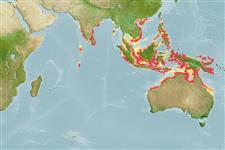>
Eupercaria/misc (Various families in series Eupercaria) >
Haemulidae (Grunts) > Plectorhinchinae
Etymology: Plectorhinchus: Greek, plektos = plaited + Greek, rhyngchos = snout (Ref. 45335).
More on author: Bleeker.
Environment: milieu / climate zone / depth range / distribution range
Ecología
marino asociado a arrecife; rango de profundidad 5 - 40 m (Ref. 90102). Tropical; 22°N - 25°S, 72°E - 153°E
Indo-West Pacific: west coast of India; Philippines and Indonesia to Papua New Guinea, south to northern Australia (Ref. 9710).
Tamaño / Peso / Age
Maturity: Lm ? range ? - ? cm
Max length : 50.0 cm TL macho / no sexado; (Ref. 48635)
Espinas dorsales (total): 12 - 13; Radios blandos dorsales (total): 19-22; Espinas anales 3; Radios blandos anales: 7 - 8. This species is distinguished by the following characters: chin with 6 pores, no median pit; gill rakers on first gill arch 7-9 + 1 + 17-20 = 26-29; Dorsal XII (rarely XIII), 19-22, 3rd-5th spines longest; lips fleshy, moderately swollen with age; scales ctenoid (rough to touch); lateral line tubed scales about 54-60; body depth 2.6-2.9 in SL; caudal fin rounded to slightly emarginate. Colour: brown to yellowish grey with 5 to 9 fairly narrow grey or white longitudinal stripes outlined with dark brown on body and continuing around snout; fins yellow, soft dorsal, caudal, and pectoral fins with darker stripes disappearing with age; eye and lips yellowish; mouth, tongue, and gill rakers scarlet; chin white; juveniles have fins striped and fewer stripes on body (Ref. 47695, 90102).
Occurs on coastal and seaward reefs. Adults on deep, current-prone slopes with rich invertebrate growth; juveniles on sheltered reefs nearby (Ref. 48635). Found singly, in small groups under ledges or large resting aggregations by day, forages for small invertebrates at night (Ref. 9710, 90102). Caught throughout its range; not common. Rarely marketed in India (Ref. 3412). Taken by handline and spear. Marketed fresh, a small quantity is salted (Ref. 47695).
Life cycle and mating behavior
Madurez | Reproducción | Puesta | Huevos | Fecundidad | Larva
Oviparous, distinct pairing during breeding (Ref. 205).
McKay, R.J., 1984. Haemulidae. In W. Fischer and G. Bianchi (eds.) FAO species identification sheets for fishery purposes. Western Indian Ocean (Fishing Area 51). Vol. 2. FAO, Rome. pag. var. (Ref. 3412)
IUCN Red List Status (Ref. 130435)
Threat to humans
Harmless
Human uses
Pesquerías: comercial
Más información
ReferenciasAcuiculturaPerfil de acuiculturaRazasGenéticaElectrophoresesheritabilidadEnfermedadesProcesamientoNutrientsMass conversion
ColaboradoresImágenesStamps, Coins Misc.SonidosCiguateraVelocidadTipo de nataciónSuperficie branquialOtolitosCerebrosVisión
Herramientas
Special reports
Download XML
Fuentes de Internet
Estimates based on models
Preferred temperature (Ref.
123201): 27 - 29.3, mean 28.7 °C (based on 1858 cells).
Phylogenetic diversity index (Ref.
82804): PD
50 = 0.5000 [Uniqueness, from 0.5 = low to 2.0 = high].
Bayesian length-weight: a=0.01778 (0.01073 - 0.02948), b=3.02 (2.88 - 3.16), in cm total length, based on LWR estimates for this species & Genus-body shape (Ref.
93245).
Nivel trófico (Ref.
69278): 4.0 ±0.66 se; based on food items.
Resiliencia (Ref.
120179): Medio, población duplicada en un tiempo mínimo de 1.4-4.4 años (Preliminary K or Fecundity.).
Fishing Vulnerability (Ref.
59153): Moderate vulnerability (40 of 100).
Nutrients (Ref.
124155): Calcium = 33.7 [12.0, 63.5] mg/100g; Iron = 0.51 [0.27, 0.96] mg/100g; Protein = 19.5 [17.7, 21.3] %; Omega3 = 0.134 [0.073, 0.216] g/100g; Selenium = 30.9 [18.2, 52.3] μg/100g; VitaminA = 81.8 [33.1, 199.7] μg/100g; Zinc = 0.995 [0.688, 1.473] mg/100g (wet weight);
